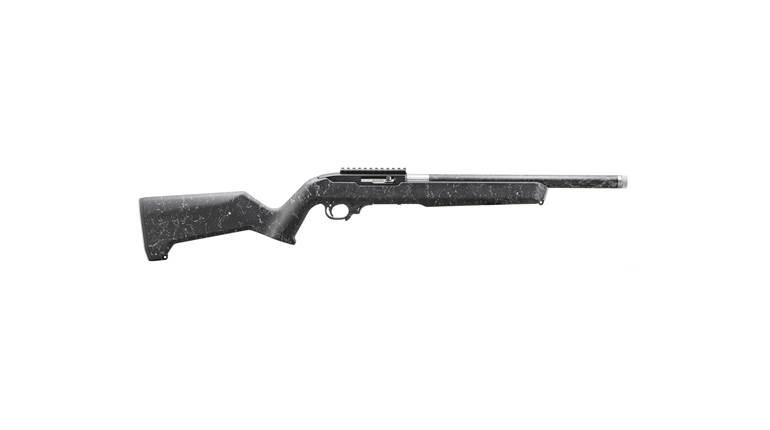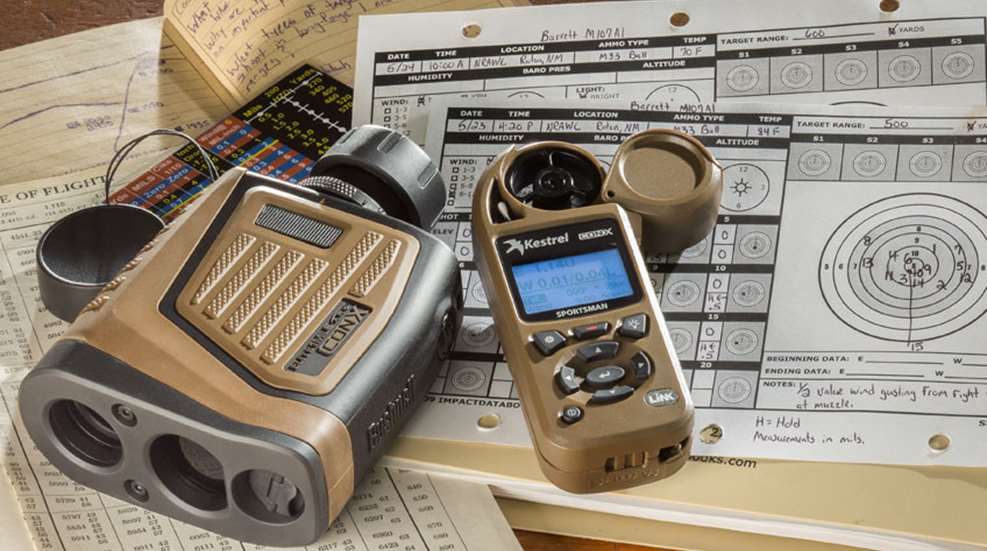
Within the sterile confines of an indoor range, accurate “point-blank” shooting isn’t terribly complex. Essentially it’s point and click; just place the sights where you want the bullet to go and then pull the trigger. Assuming your fundamentals are solid, your ammunition is quality and your firearm is reasonably accurate, your target will be satisfyingly perforated. But out in the field, where the wind never seems to stop blowing and shots often stretch out into the curvier portions of a trajectory chart, putting your bullet exactly where you want it to go becomes much trickier.
Until fairly recently, riflemen had to learn to compensate for factors such as wind deflection and bullet drop (and even far more complex variables) through rough visual estimation and a lifetime of trial-and-error. But that also meant throwing it all out and starting over any time the shooter changed rifles or even loads. With today’s technology, however, which utilizes the relatively new luxuries of laser rangefinders and weather meters, the guesswork of shooting at longer ranges can be all but eliminated. One example is Bushnell’s new Elite 1 Mile CONX Combo that wirelessly links the two pieces of kit together via Bluetooth in a way that’s never been done before. Pairing the company’s Elite 1 Mile CONX rangefinder with a Kestrel Sportsman Ballistic Weather Meter, it offers a ballistics system that simplifies intricate firing solutions back down to point and click.
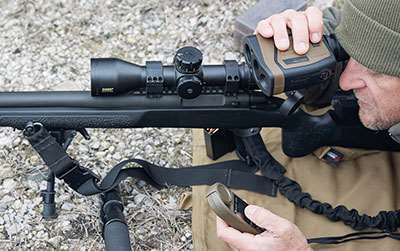
While on a late-March aoudad hunt with me in the Davis Mountains of West Texas, Bushnell Events Manager John Vaca called the system “confidence in a box.” After having the opportunity to put the system to the test using a broad variety of cartridges, scopes, shot distances and weather conditions, I think his assessment is right on the money. The notion of long-range shooting can be daunting to the uninitiated, but the CONX Combo makes it so simple that virtually any competent short-range shooter should be able to use the system to connect with targets as far out as his cartridge of choice will let him.
First, let’s take a quick look at the system’s two components. The Elite 1 Mile CONX is a 7X 26 mm rangefinder that operates by emitting a series of invisible infrared pulses and then measuring the amount of time it takes for each pulse to reflect off the target and return to the optical unit. It then calculates the distance to the target and renders it in the rangefinder’s heads-up display. As suggested by its name, the company advertises the Elite 1 Mile CONX to have a maximum range of 1,760 yds. (or one mile), providing readings accurate up to within a 1/2 yd.

In order to test its accuracy, I used the tool to find the range of several items and then manually measured the actual distance—in each test I found the rangefinder’s value to be within 8" of the measured distance. Bushnell’s rangefinder also features a built-in accelerometer that measures the angle from the user’s position to the target and accounts for the effects of that angle in its calculations. The unit features tactile rubber texturing on its exterior that makes it easier to grip. It also runs off one CR123 battery, is waterproof and weighs 13.5 ozs.
Many forces act upon a projectile in flight, and the Kestrel Sportsman Ballistic Weather Meter was designed to measure virtually all of them. An array of sensors in and on the meter evaluates the ambient temperature, humidity, altitude and barometric pressure, and an anemometer located in the top of the Kestrel is capable of providing wind speed values in the immediate vicinity of the shooter. Windage information along the entire flight path of the projectile would be ideal, but wind values in close proximity to the shooter are still valuable to have, as it is early in the shot that the wind has the greatest capacity to knock a bullet off course.
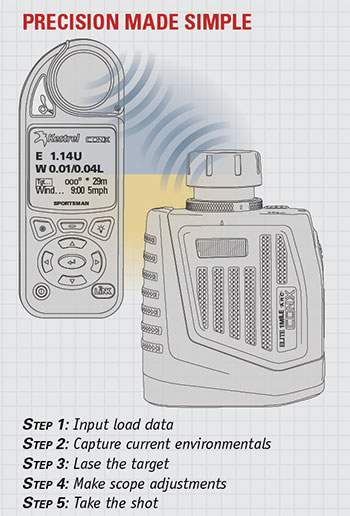 The Kestrel Sportsman runs on a single lithium AA battery and weighs only 4.7 ozs. Both the weather meter and the rangefinder wear the same Coyote Brown finish, each can be mounted to the top of a tripod, and a wind vane mount comes with the combo. Although now offered as a bundle, the two components can be purchased separately, and the Elite 1 Mile CONX will connect with any Kestrel Sportsman or Elite models that feature the Link system. Bushnell’s rangefinder can also wirelessly link via Bluetooth with nearly any smartphone equipped with the company’s free CONX ballistic app.
The Kestrel Sportsman runs on a single lithium AA battery and weighs only 4.7 ozs. Both the weather meter and the rangefinder wear the same Coyote Brown finish, each can be mounted to the top of a tripod, and a wind vane mount comes with the combo. Although now offered as a bundle, the two components can be purchased separately, and the Elite 1 Mile CONX will connect with any Kestrel Sportsman or Elite models that feature the Link system. Bushnell’s rangefinder can also wirelessly link via Bluetooth with nearly any smartphone equipped with the company’s free CONX ballistic app.
So how does the system work? It is simultaneously mind-numbingly complex and effortlessly simple. Remember all those forces that affect a projectile in flight? The CONX Combo’s intricate ballistic algorithms provide a shooting solution in an instant, allowing the shooter to forget about those variables completely and get back to focusing on the fundamentals. With the system computing hold-overs immediately in the field, all that’s left for the shooter to do is to skillfully execute the adjustments. The unit’s ballistic software, provided by Applied Ballistics, can even account for additional advanced factors such as aerodynamic jump, spin drift and the Coriolis effect.
It all sounds more difficult than running the equipment actually is. First, input the load and equipment data into the Kestrel. Required information includes: the load’s muzzle velocity, ballistic coefficient, bullet weight, bullet diameter, bullet length, drag model, the range at which the gun’s scope was zeroed, the barrel’s twist rate and the scope’s height over bore and adjustment click values (the system works equally well with m.o.a.- and milliradian-adjustable scopes). Most of this information can be found on the ammunition box or the manufacturer’s website, and the Kestrel Sportsman can store up to three unique gun/ammunition profiles in its memory at once (the Elite can hold 10).
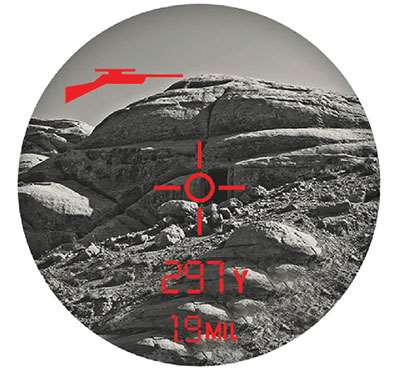
Once the load information has been entered and the CONX and Kestrel have been linked together—a process that takes only seconds—the system is ready to go shooting. Out in the field, all that’s necessary is for the shooter to use the weather meter to capture the current environmental conditions and take a wind reading, and then use the rangefinder to determine the distance to the target. As the target is lased, both the rangefinder’s HUD and the Kestrel’s display will provide the necessary elevation adjustment for the scope being used. In addition, the weather meter will also provide holds for both 5- and 10-mph full-value winds—just extrapolate to determine the right hold for the shot’s particular wind conditions. As the target’s distance changes, using the CONX again to reacquire the new range will cause the adjustment values to update in real time. Equipped with these hold-over values, all the shooter must do is dial-in his or her scope to the appropriate elevation setting, assume the proper windage hold and pull the trigger.
 As mentioned previously, my first experience with Bushnell’s new system came in early spring during an aoudad hunt with Offgrid Outdoors in Texas’ Big Bend Country. I used a Savage Model 111 Long Range Hunter chambered in .300 Win. Mag. and topped with a Bushnell Elite LRHS scope. I used Federal Premium’s 150-gr. Fusion load. Aoudad are wary creatures with keen vision; they are capable of pinpointing a hunter’s location and moving out of range long before he even becomes aware of their presence. Naturally, the assumption was that any shots taken during this trip would take place at long range—making the hunt an ideal opportunity to field test the accuracy of the CONX Combo at extended distances.
As mentioned previously, my first experience with Bushnell’s new system came in early spring during an aoudad hunt with Offgrid Outdoors in Texas’ Big Bend Country. I used a Savage Model 111 Long Range Hunter chambered in .300 Win. Mag. and topped with a Bushnell Elite LRHS scope. I used Federal Premium’s 150-gr. Fusion load. Aoudad are wary creatures with keen vision; they are capable of pinpointing a hunter’s location and moving out of range long before he even becomes aware of their presence. Naturally, the assumption was that any shots taken during this trip would take place at long range—making the hunt an ideal opportunity to field test the accuracy of the CONX Combo at extended distances.
It was a sound theory, ruined only by unexpected good fortune. After spending nearly two hours stalking toward a huge ram, my guide and I carefully poked our heads around a large shrub to find that, instead of being where we anticipated the animal to be—somewhere in the vicinity of 400 to 500 yds. from our position—it was, in fact, now only 70 yds. away, totally oblivious to our presence.
No thought whatsoever was given to allowing the ram to retreat to a distance that might more adequately test the CONX Combo; the first shot I was given, I took. That ended up being a broadside shot at 180 yds. that penetrated both lungs and dropped the beast after only a few steps. Although the action ended up taking place at a range well within the .300 Win. Mag.’s point-blank capabilities, we did still frequently take readings with the rangefinder and adjust my scope’s turret accordingly as the ram mulled around for several minutes before offering me a clean shot. The shooting solution provided by the CONX Combo was on the nose.
However, when I returned home from hunting, I still wanted to test the CONX/Kestrel system in different scenarios before I felt confident in its precision. So, during several trips to multiple ranges, I used both m.o.a. and mil-dot scopes, along with a diverse mixture of chamberings—including some appreciated for their flat trajectories and high ballistic coefficients, as well as others known more for their tendency to sink like a rock after a few hundred yds.—to test the equipment. In all instances, the projectile unerringly found its way to its target—whether that object was a 10" steel plate, a paper bullseye or the kill zone of a Barbary sheep. I was able to test the CONX Combo out to 600 yds., and even at longer ranges, the hold-over values provided by the system were reliable. Applied Ballistics certainly seems to have gotten all of its formulas right.
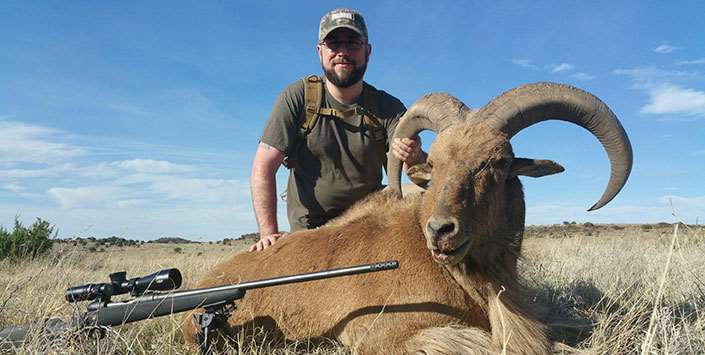
Long-range shooting is more popular today than it ever has been, which means that Bushnell is hitting the market with this product at just the right time. The technology available in the Elite 1 Mile CONX Combo is impressive, and impressive technology doesn’t come cheap. At a suggested retail price of $1,149 for the pair, the system is not inexpensive, and some casual or novice shooters may understandably balk at the price tag.
That is a shame, because it is exactly those less-seasoned riflemen who would reap the most benefit from the confidence-boosting simplicity of the CONX Combo. And I have a feeling many such skeptics would quickly change their tunes if given the opportunity to spend the day with one in the field—it’s essentially like carrying a shooting instructor around in your pocket. On the other hand, serious long-range shooters and hunters—who understand the functionality, versatility and convenience offered by such a product and who appreciate the value of investing in good equipment—will find it to be well worth the cost.
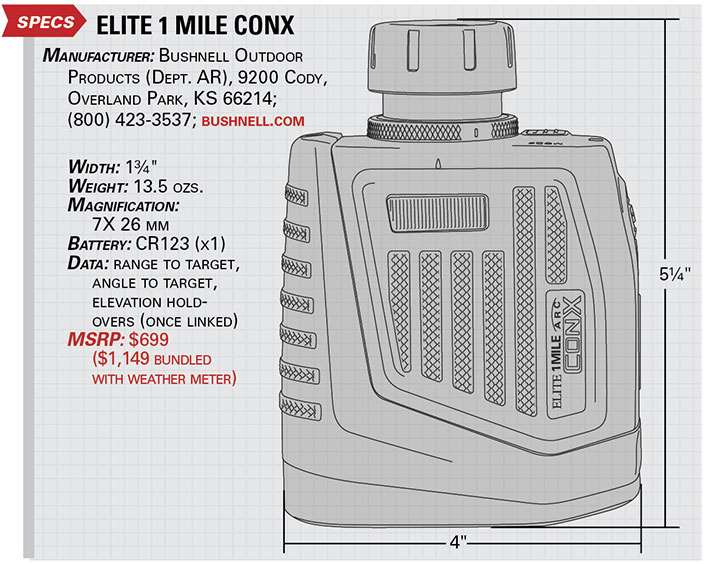
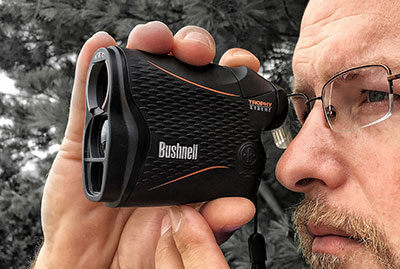 Bushnell Trophy Xtreme: A Bear Necessity
Bushnell Trophy Xtreme: A Bear Necessity
Bushnell has a long history of innovation when it comes to pairing electronics with optics, and the new CONX Combo system is another notch in the company’s belt. I can attest from recent experience that the quality and innovation seen in the company’s high-profile introductions is also trickling down to the more affordable product lines. I recently had the opportunity to put Bushnell’s Trophy line to work by traveling to Canada in pursuit of spring black bear.
Black and dark targets, especially furry ones like the black bears we hunted, have notoriously plagued users of laser rangefinders in the past. Bushnell answered the problem of wavelength-absorbing colors with its Trophy Xtreme series rangefinder by incorporating Full Spectrum Targeting technology. Small, compact and ultra-lightweight at just 5.3 ozs., the 4X 20 mm rangefinder features enough magnification to pinpoint distant objects and provides near instant feedback in a crystal clear viewfinder with black digital readouts. The Trophy Xtreme rangefinder worked as advertised, and I quickly received readings on multiple moving targets, including the eight bears I encountered. Testing the optic unsupported by aiming at pure black objects out to 600 yds. consistently yielded trustworthy results. The unit has an accuracy rating to within 1 yd. and is capable of ranging from 7 to 850 yds. Simple and utilitarian by design, the Trophy Xtreme rangefinder commands a price of $299, well within most hunters’ budgets.
I knew going into this hunt that I would be spending time in the glass during the waning hours of daylight. Having taken several other Bushnell products along for testing—a Trophy 3-9X 40 mm riflescope and the Trophy XLT 10X 42 mm binoculars—I knew I would need those optical enhancements to find targets and accurately fire the .338 Federal-chambered Savage Model 16 Weather Warrior I toted along.
Glassing through dense poplar stands laced with stagnant water provided a chance to admire what the company is doing with its lenses and coatings in the Trophy XLT binoculars and riflescope. It is worth noting that value generally comes with compromise, and from my years of experience hunting on a strict budget, I was familiar with earlier Bushnell economy products, and not entirely satisfied. Testing the newest Trophy line of optics, I found sharpness and color fidelity to be excellent, and easily picked up on small details through the swaying trees and shimmering sunlight—whether it be a duck strolling by, a ground squirrel or an approaching black bear. Another confidence booster, after bouncing around in the cargo holds of two 747s, customs checks, and enduring other rough and tumble transit, the $190 riflescope remarkably held zero and was just four, 1/4"-clicks high when range-checked before hunting.
The first night of the hunt proved I was set up in a good area. Just moments after legal shooting time, sitting unloaded and awaiting pickup, a large mature black bear came to 14 yds., circled the bait and leisurely walked off into the darkness. I knew that bear would be back, and on the second-to-last night of the hunt, a second encounter ended at 62 yds., just 10 minutes before last light. Federal Premium Ammunition’s Trophy Copper bullet did exactly what it was supposed to do: drop the large bear with a single shot threaded through a small 6"x3" opening in diminishing light—a testament to gear, practice and patience.
—Christopher Olsen, Assistant Editor












